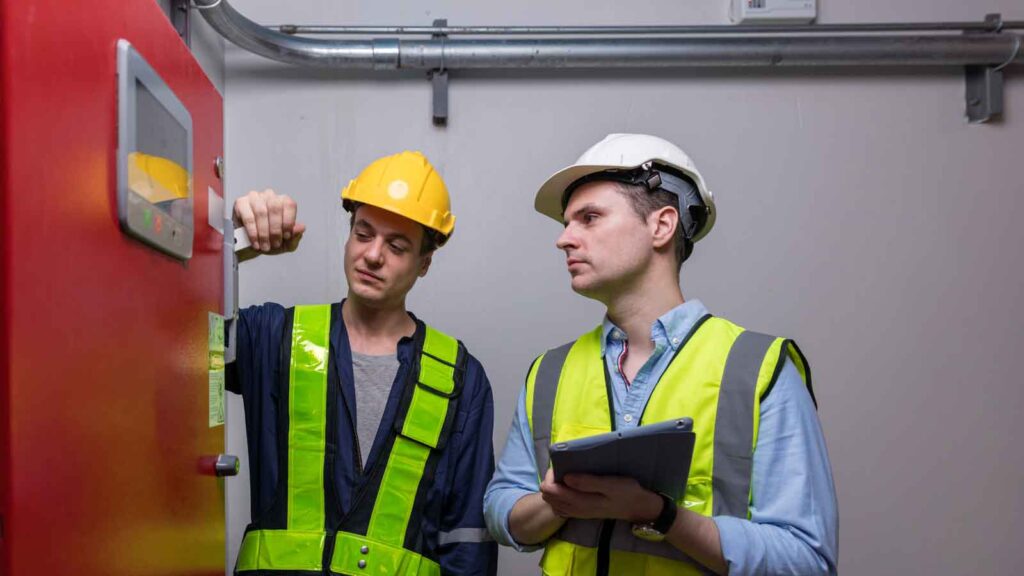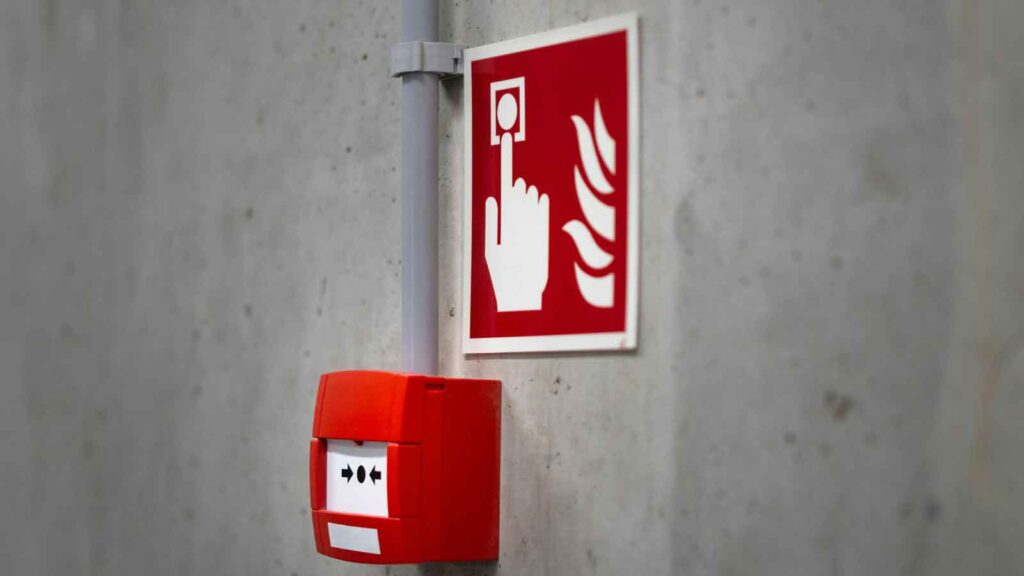Fire safety is a priority for every property owner and manager, but keeping up with inspection requirements can feel overwhelming. Unclear schedules, changing codes, and varying local enforcement often leave many unsure of what to do.
Now more than ever, missing an inspection is not just a compliance issue but also a serious safety risk.
Part of the challenge is that inspection frequency depends on both state law and national standards. In California, strict codes outline when and how fire alarm systems must be checked. Without a clear understanding of these rules, property owners can face costly penalties and, more importantly, unreliable fire protection.
That is why knowing how often inspections are required is so important. In this guide, we’ll explain how frequently fire alarm inspections must be done in California, what state laws and national standards say, and how local enforcement plays a role. We’ll also look at what goes into a comprehensive fire alarm inspection so you know exactly what to expect.
What Are Fire Alarm Inspections?
Fire alarm inspections are scheduled evaluations of a building’s fire alarm system to confirm it is working as intended. These inspections involve checking individual components such as detectors, panels, alarms, and communication systems. The process ensures that each part of the system can perform its role during an emergency.
Fire alarm inspections matter because they:
- Identify malfunctions before they become emergencies
- Ensure compliance with California fire codes and NFPA standards
- Document safety measures for audits and insurance purposes
- Protect occupants by maintaining reliable early warning systems
Inspectors conduct both visual reviews and functional tests. Visual reviews check for physical damage or obstructions, while functional tests verify signals, alarms, and communications are operational.
Regular inspections keep fire alarm systems in peak condition and confirm compliance with legal requirements. They also reduce liability for owners and provide peace of mind for occupants. Without them, even minor issues like a weak battery or a blocked detector can compromise safety and put lives at risk.
California State Law Requirements for Fire Alarm System Inspections
California law is clear about the responsibilities of property owners regarding fire alarm inspections. These requirements are established to protect lives, minimize liability, and ensure systems function properly during emergencies.
To understand how compliance works in practice, let’s look at the laws and standards that apply.
California Fire Code Mandates and Building Safety Standards
The California Fire Code is the primary source of regulation for fire alarm inspections. It outlines the frequency of inspections, testing, and maintenance required for various types of properties. The rules apply to commercial buildings, schools, residential complexes, and healthcare facilities.
The role of government in fire safety standards is central to this process. By adopting uniform codes, the state ensures that safety is consistent regardless of location. This helps reduce confusion and establishes a baseline level of protection for all occupants.
Compliance is mandatory, and failure to follow the Fire Code can result in citations, fines, or orders to correct deficiencies. For property managers, staying on schedule with inspections is not just a legal box to check but a responsibility tied to public safety.
NFPA 72 National Fire Alarm Code Adoption in California
California also follows NFPA 72, which is the national benchmark for fire alarm inspection and maintenance. This code sets the standard for how systems are designed, installed, tested, and maintained. By adopting NFPA 72, California aligns with nationwide best practices.
NFPA 72 goes into detail about specific inspection intervals for different system components. For example, it distinguishes between daily visual inspections, monthly testing, and annual full-system evaluations. This level of detail helps standardize safety across buildings of all types.
Because NFPA 72 is updated regularly, California ensures its regulations stay current with modern technology and evolving safety needs. Property owners are expected to keep pace with these changes to remain compliant.
Local Authority Having Jurisdiction Enforcement Powers
Enforcement of California’s fire codes is carried out by the local Authority Having Jurisdiction, often the city or county fire marshal. The AHJ has the power to interpret requirements, conduct inspections, and issue violations. Their role ensures that fire safety rules are not just written but applied in real situations.
During inspections, AHJs may review fire alarm logs, testing reports, and maintenance records. Missing or incomplete documentation is a common cause of compliance issues. They can also require corrective actions or additional inspections if they find potential risks.
Because AHJs vary by location, property owners must confirm specific local requirements in addition to state and national codes. Staying proactive with communication helps prevent costly misunderstandings.
How Often Fire Alarm Inspections Are Required in California Based on System Components
Inspection frequency in California is based on the type of component being checked. Some require quick daily or weekly checks, while others need professional testing at longer intervals. Understanding these schedules ensures that no part of the system is overlooked.
Daily and Weekly Visual Inspection Requirements
Basic visual inspections are required on a daily and weekly basis. These checks confirm that fire alarm panels show a normal operating status without trouble signals. They also ensure connections to monitoring services remain active.
Daily inspections can be handled by trained building staff. Weekly inspections may include a more careful look at specific devices or connections. While simple, these checks are essential for catching problems early.
Keeping logs of daily and weekly inspections provides proof of compliance and reduces surprises during official inspections. It also helps detect minor issues before they compromise the entire system.
Monthly and Quarterly System Testing Schedules
California requires functional testing of specific system components on a monthly or quarterly basis. This includes testing smoke detectors, manual pull stations, and notification appliances, such as horns and strobes.
Fire protection services usually perform these tests to ensure accuracy and compliance. They simulate alarm events to confirm that devices activate properly and that signals reach control panels and monitoring centers.
Monthly and quarterly testing creates an added layer of assurance. It verifies that systems respond as intended between comprehensive inspections and ensures reliability in emergencies.
Semi-Annual Communication and Battery System Checks
Every six months, communication pathways and backup power systems must be inspected and maintained. This includes testing phone lines, cellular transmitters, and internet-based alarm communication devices. Batteries that provide power during outages must also be checked.
These inspections are critical because communication failures can prevent alarm signals from reaching fire departments. Batteries are equally crucial since fires often occur alongside power failures.
Semi-annual inspections confirm that the system has reliable backups in place. Without them, alarms may sound locally but fail to notify emergency responders in time.
Annual Comprehensive Fire Alarm System Performance Testing
Once a year, California requires a full-scale performance test of the fire alarm system. This must be done by licensed professionals who are trained in both state and NFPA 72 requirements.
The annual test evaluates every component of the system. Inspectors activate devices, check control panels, verify signals, and confirm backup power. They simulate fire conditions to ensure all parts work together seamlessly.
Documentation from this inspection is vital for compliance. Property owners must keep detailed reports on file for review by AHJs, insurance providers, or auditors. Missing an annual test can lead to fines and legal consequences.
Best Practices for Maintaining Fire Alarm Inspection Compliance in California
Staying compliant with California’s inspection requirements means more than scheduling annual checks. Property owners and managers need a structured approach that ensures no inspections are missed and all records are correctly maintained. Having clear procedures in place reduces the risk of violations and keeps occupants safe.
Key steps to always consider include the following approach:
- Keep detailed inspection and maintenance logs for all system checks
- Schedule inspections in advance to avoid missed deadlines
- Train staff to handle daily and weekly visual checks accurately
- Partner with licensed contractors for professional inspections and repairs
- Review local Authority Having Jurisdiction (AHJ) requirements regularly
These actions form the foundation of consistent compliance and demonstrate a commitment to safety. Following the best practices for fire prevention also helps extend the life of fire alarm systems and reduces long-term maintenance costs.
Building owners should also foster communication with local fire authorities and trusted contractors. Doing so ensures that inspections meet both state and local requirements. Staying proactive avoids last-minute issues and keeps properties legally protected.
By making compliance a routine priority, property managers create safer environments while minimizing liability.
Key Takeaways
Fire alarm inspections are more than a compliance requirement in California. They serve as a safeguard to ensure that every system component is ready to perform during a fire. The laws and standards may feel complex, but they exist to provide consistency and reliability across all types of buildings.
Property owners who treat inspections as part of routine operations see the most benefit. Consistent scheduling, proper documentation, and collaboration with licensed contractors simplify compliance and reduce long-term costs.
Ultimately, these inspections provide peace of mind, knowing that the system protecting your property and the people inside is tested, verified, and dependable.




